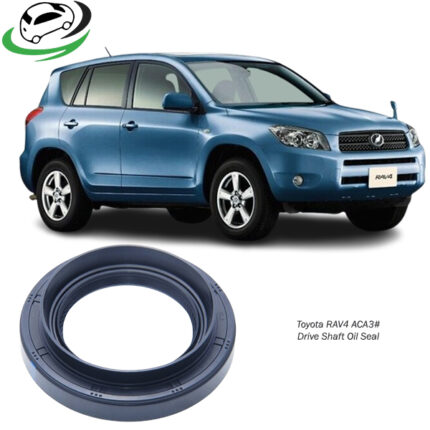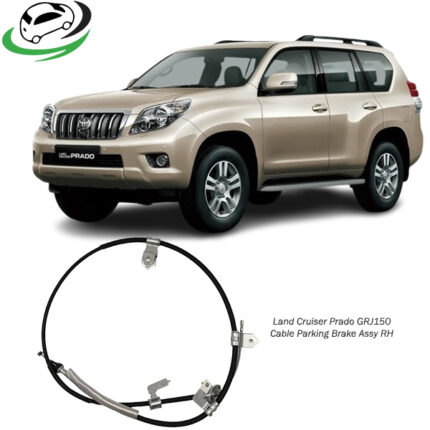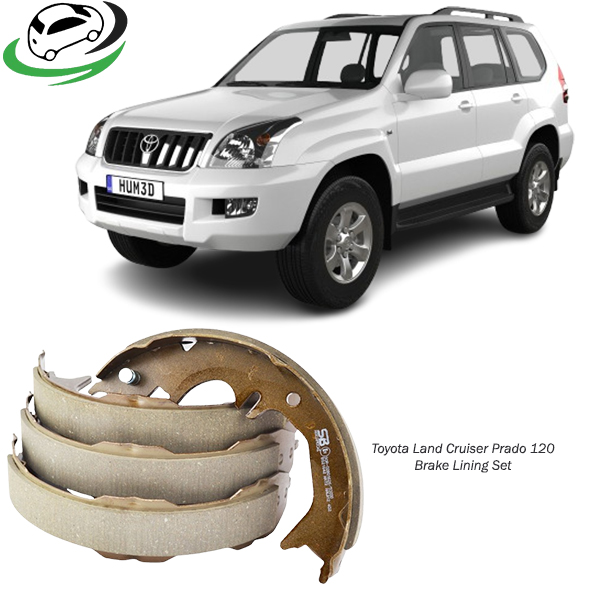-7%
Get Toyota Prado Land Cruiser 120 Series Brake Lining Set 46580-60060
The Toyota Prado Land Cruiser 120 Series is renowned for its reliability, off-road capabilities, and robust performance. An essential component of its braking system is the brake lining set, which plays a critical role in ensuring the vehicle’s safe stopping power. This comprehensive guide explores the purpose, design, types, materials, benefits, installation, maintenance, and troubleshooting of the Toyota Prado Land Cruiser 120 Series brake lining set, providing valuable insights for vehicle owners and automotive professionals.
1. Purpose of Brake Linings
a. Friction Generation
Brake linings are designed to create friction against the brake rotors (in disc brake systems) or drums (in drum brake systems) when the brakes are applied. This friction is crucial for slowing down or stopping the vehicle effectively. In the Toyota Prado 120 Series, the brake lining set is engineered to provide optimal stopping power under various driving conditions, from highway cruising to off-road adventures.
b. Heat Dissipation
During braking, heat is generated due to the friction between the brake lining and the rotor or drum. Brake linings must effectively absorb and dissipate this heat to prevent brake fade—a condition where the braking performance diminishes due to overheating. Quality brake linings in the Prado ensure that the vehicle maintains consistent braking performance, even during extended use.
c. Noise Reduction
High-quality brake linings are also designed to minimize noise during operation. They include features that dampen vibrations and reduce sound levels, contributing to a quieter driving experience.
2. Design and Composition of Brake Linings
a. Construction
The brake lining set for the Toyota Prado Land Cruiser 120 Series typically comprises several layers:
- Friction Material: The outer layer, which is responsible for generating friction when pressed against the brake rotor or drum.
- Backing Plate: A sturdy base that provides structural support to the friction material and facilitates attachment to the brake assembly.
- Adhesive Layer: An adhesive that bonds the friction material to the backing plate, ensuring durability under high temperatures and pressure.
b. Materials Used
The materials chosen for the brake linings can significantly impact performance and longevity. Common materials include:
- Organic Linings: Made from a combination of fibers, rubber, and resins. These linings are typically quieter and produce less dust but may wear out faster compared to other materials.
- Semi-Metallic Linings: These contain metal fibers (e.g., copper or steel) that enhance durability and heat resistance. They offer excellent stopping power but may produce more noise and dust.
- Ceramic Linings: Composed of ceramic fibers mixed with other materials, ceramic linings provide low dust production, quiet operation, and good performance across a range of temperatures.
3. Types of Brake Linings for the Prado 120 Series
The Toyota Prado Land Cruiser 120 Series may feature either disc or drum brake systems, depending on the configuration. Understanding the types of brake linings is essential for proper selection:
a. Disc Brake Linings
In disc brake systems, the brake lining (commonly referred to as a brake pad) is mounted on the brake caliper. When the driver presses the brake pedal, the caliper squeezes the pads against the rotor, creating friction to slow the vehicle. The Prado 120 Series is equipped with disc brakes on the front and, in many configurations, the rear as well.
b. Drum Brake Linings
In vehicles that utilize drum brakes, the brake lining is part of a brake shoe assembly. When the brake pedal is pressed, the shoes expand and press against the inner surface of the drum, generating the necessary friction to stop the vehicle. Depending on the specific model and trim of the Prado 120 Series, drum brakes may be present on the rear wheels.
4. Benefits of Quality Brake Linings
Investing in high-quality brake linings for the Toyota Prado Land Cruiser 120 Series yields numerous advantages:
a. Enhanced Safety
Quality brake linings ensure reliable and consistent stopping power, enhancing the overall safety of the vehicle. This is particularly important for a vehicle designed for off-road use, where braking conditions may vary significantly.
b. Improved Performance
Premium brake linings can withstand higher temperatures and provide better friction characteristics, resulting in enhanced braking response and shorter stopping distances.
c. Longevity
Durable materials in brake linings extend their lifespan, reducing the frequency of replacements and lowering maintenance costs. This is crucial for the Toyota Prado, as regular off-road driving can put additional stress on braking components.
d. Noise Reduction
High-quality linings often feature designs that minimize noise and vibrations during braking, leading to a more enjoyable driving experience.
5. Installation of Brake Lining Sets
Proper installation of brake linings is vital for ensuring optimal braking performance and safety. Here’s a step-by-step guide to installing brake lining sets in the Toyota Prado Land Cruiser 120 Series:
a. Tools and Equipment Needed
- Jack and jack stands
- Lug wrench
- Brake cleaner
- Torque wrench
- Brake lining tool (optional)
- Safety goggles and gloves
b. Step-by-Step Installation Process
- Prepare the Vehicle:
- Park the vehicle on a level surface and engage the parking brake.
- Loosen the lug nuts on the rear wheels without removing them completely.
- Lift the Vehicle:
- Use a jack to lift the rear or front of the vehicle (depending on which brake linings are being replaced) and secure it with jack stands.
- Remove the Wheel:
- Fully remove the lug nuts and take off the wheel to access the brake components.
- Remove Old Brake Linings:
- For disc brakes, detach the brake caliper and remove the old brake pads. For drum brakes, remove the drum to access the brake shoes and linings.
- Take note of the arrangement and orientation of the old linings for reference during installation.
- Clean the Brake Assembly:
- Use brake cleaner to remove dust, dirt, and debris from the brake assembly. Ensure that the surfaces are clean for the new linings to adhere properly.
- Install New Brake Linings:
- For disc brakes, slide the new brake pads into the caliper bracket, ensuring they are properly seated.
- For drum brakes, position the new brake shoes and secure them in place. Ensure they are aligned with the hardware.
- Reassemble Components:
- Reinstall the brake caliper or drum, ensuring all fasteners are tightened to the manufacturer’s specifications.
- Reattach the Wheel:
- Place the wheel back on and hand-tighten the lug nuts. Then lower the vehicle back to the ground.
- Torque the Lug Nuts:
- Once the vehicle is back on the ground, use a torque wrench to tighten the lug nuts to the specified torque rating.
- Test the Brakes:
- Before driving, pump the brake pedal a few times to ensure proper engagement and feel. Check for any unusual noises or behavior.
6. Maintenance of Brake Linings
Regular maintenance of brake linings is crucial for extending their lifespan and ensuring safe braking performance. Here are some maintenance tips:
a. Regular Inspections
Conduct regular visual inspections of brake linings for signs of wear, cracking, or damage. Check for uneven wear patterns, which may indicate alignment or suspension issues.
b. Monitor Brake Performance
Pay attention to any changes in braking performance, such as decreased responsiveness or unusual noises. Early detection of issues can prevent further damage.
c. Brake Dust Cleaning
Regularly clean brake dust from the wheels and brake components to prevent buildup. Excessive dust can lead to corrosion and wear on components.
d. Brake Fluid Checks
Ensure that the brake fluid is at the proper level and condition. Replace brake fluid according to the vehicle manufacturer’s recommendations to maintain optimal braking performance.
7. Signs of Wear and When to Replace Brake Linings
Recognizing the signs of wear is essential for maintaining effective braking performance. Common indicators that brake linings may need replacement include:
a. Squeaking or Grinding Noises
A high-pitched squeaking noise when applying the brakes often indicates that the brake linings are worn and may need replacement. Grinding noises can indicate that the linings are completely worn down, leading to metal-to-metal contact.
b. Reduced Braking Efficiency
If the vehicle takes longer to stop or the brake pedal feels spongy or unresponsive, it may indicate that the brake linings are worn and need replacing.
c. Vibration or Pulsation
Feeling vibrations or pulsations in the brake pedal when braking may signal uneven wear or glazing of the brake linings, necessitating inspection and potential replacement.
d. Visible Wear Indicators
Many brake linings have built-in wear indicators that signal when it’s time for replacement. If the indicator is visible, it’s time to replace the linings.
e. Brake Dust Accumulation
Excessive brake dust buildup on the wheels may indicate that the brake linings are deteriorating and need to be replaced.
8. Conclusion
The brake lining set in the Toyota Prado Land Cruiser 120 Series is a vital component of its braking system, contributing significantly to the vehicle’s safety and performance. Understanding the purpose, design, types, benefits, installation, maintenance, and signs of wear associated with brake linings is essential for vehicle owners and automotive professionals. By prioritizing the selection of quality brake linings and adhering to proper maintenance practices, drivers can enhance their vehicle’s braking performance, improve safety, and extend the lifespan of braking components.
Follow us on Facebook for more parts.




Reviews
Clear filtersThere are no reviews yet.